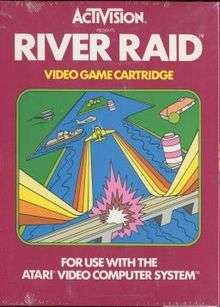River Raid
River Raid is a vertically scrolling shooter designed and programmed by Carol Shaw and published by Activision in 1982 for the Atari 2600 video game console.[3] Over a million game cartridges were sold.[4] Activision later ported the title to the Atari 5200, ColecoVision, and Intellivision consoles, as well as to the Commodore 64, IBM PCjr, MSX, ZX Spectrum, and Atari 8-bit family. Shaw did the Atari 8-bit and Atari 5200 ports herself.[5]
| River Raid | |
|---|---|
 Box art | |
| Developer(s) | Activision |
| Publisher(s) | Activision |
| Designer(s) | Carol Shaw[1] |
| Programmer(s) | Carol Shaw |
| Platform(s) | Atari 2600, Atari 8-bit, Atari 5200, ColecoVision, Intellivision, MSX, IBM PCjr, ZX Spectrum, Commodore 64 |
| Release | 1982: 2600[1][2] 1983: Atari 8-bit, 5200 1984: C64, Spectrum |
| Genre(s) | Scrolling shooter |
| Mode(s) | Single-player |
Activision published a less successful sequel in 1988 without Shaw's involvement.
Gameplay

Viewed from a top-down perspective, the player flies a fighter jet over the River of No Return in a raid behind enemy lines. The player's jet can only move left and right—it cannot maneuver up and down the screen—but it can accelerate and decelerate. The player's jet crashes if it collides with the riverbank or an enemy craft, or if the jet runs out of fuel. Assuming fuel can be replenished, and if the player evades damage, gameplay is essentially unlimited.
The player scores points for shooting enemy tankers (30 points), helicopters (60 points), fuel depots (80 points), jets (100 points), and bridges (500 points). The jet refuels when it flies over a fuel depot. A bridge marks the end of a game level. Non-Atari 2600 ports of the game add hot air balloons that are worth 60 points when shot as well as tanks along the sides of the river that shoot at the player's jet.
Destroying bridges also serve as the game's checkpoints. If the player crashes the plane they will start their next jet at the last destroyed bridge.
Development
For its time, River Raid provided an inordinate amount of non-random, repeating terrain despite constrictive computer memory limits. The game program does not actually store the sequence of terrain and other objects. Instead, a procedural generation algorithm manifests them by employing a linear feedback shift register with a hard-coded vector.[6] Because this starting value is hard-coded, the algorithm generates the same game world every time the program executes. The enemy crafts' AI, however, relies on a random number generator to make enemy movement less predictable.
Reception
InfoWorld in 1983 stated that River Raid might be the best Atari 8-bit game of the year, "more challenging than any VCS version" and superior to others like Caverns of Mars.[7] Antic in 1984 said that the Atari 8-bit version was identical to the 2600 original, but with slightly "spiffed up ... game visuals".[8] The Deseret News in 1984 called River Raid "one of the most playable and entertaining of all war games". The newspaper gave the ColecoVision version four stars, recommending it to all console owners and describing it as "a definite winner all the way".[9] The game received the award for "1984 Best Action Videogame"[10]:42 and a Certificate of Merit in the category of "1984 Best Computer Action Game" at the 5th annual Arkie Awards,[11]:28 where the judges described it as "provid[ing] the brand of non-stop excitement the blast brigaders adore".[10]:42
River Raid was the first video game to be banned for minors in West Germany by the Federal Department for Writings Harmful to Young Persons (German: Bundesprüfstelle für jugendgefährdende Schriften).[12]
Legacy
In 1996, Next Generation listed the Atari 2600 version as number 81 on their "Top 100 Games of All Time", commenting that, "Nostalgia aside, the 2600 sucks. ... But this game is still great, for one main reason: Level design."[13]
Activision published the relatively obscure River Raid II for the Atari 2600 in 1988. This sequel, programmed by David Lubar based on a concept by Dan Kitchen,[14] has similar gameplay, but with a different landscape and increased difficulty.
In 1995 River Raid was published for Microsoft Windows as part of Activision's Atari 2600 Action Pack.[15]
References
- Buchanan, Levi (2008-04-08). "Top 10 Classic Shoot 'Em Ups". IGN. Retrieved 21 March 2012.
- "Release date". GameRankings. Retrieved 20 March 2012.
- Hague, James. "The Giant List of Classic Game Programmers".
- http://www.vintagecomputing.com/index.php/archives/800
- Edwards, Benj (October 12, 2011). "VC&G Interview: Carol Shaw, Atari's First Female Video Game Developer". Vintage Computing and Gaming.
- Aycock, John (2016). Retrogame Archeology: Exploring Old Computer Games (1st ed.). Springer. p. 130. ISBN 978-3319300023.
One of River Raids LSFRs was eight-bit, with taps b4 and b7, and the other was a 16-bit LSFR that was used for PCG.
- Mace, Scott (1983-11-07). "Electronic Antics". InfoWorld. pp. 73–74. Retrieved 15 February 2015.
- Duberman, David (January 1984). "ROM Fun: Survey of recent cartridge games". Antic. pp. 62–63.
- Holyoak, Craig (1984-05-30). "Here are ColecoVision's jewels". Deseret News. pp. 4 WV. Retrieved 10 January 2015.
- Kunkel, Bill; Katz, Arnie (January 1984). "Arcade Alley: The Arcade Awards, Part 1". Video. Reese Communications. 7 (10): 40–42. ISSN 0147-8907.
- Kunkel, Bill; Katz, Arnie (February 1984). "Arcade Alley: The 1984 Arcade Awards, Part II". Video. Reese Communications. 7 (11): 28–29. ISSN 0147-8907.
- Wolf, Mark J. P. (2012-01-01). Encyclopedia of Video Games: A-L. ABC-CLIO. ISBN 9780313379369.
- "Top 100 Games of All Time". Next Generation. No. 21. Imagine Media. September 1996. p. 43.
- Hague, James (1997). "Halcyon Days: Interviews with Classic Computer and Video Game Programmers".
- http://uk.ign.com/games/activisions-atari-2600-action-pack/pc-724812
External links
- River Raid for the Atari 2600 at Atari Mania
- River Raid for the Atari 8-bit family at Atari Mania
- River Raid at Lemon 64
- The Atari 2600 version of River Raid can be played for free in the browser at the Internet Archive
